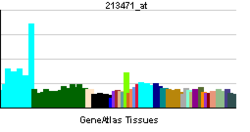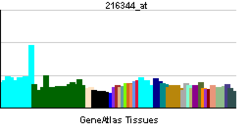- NPHP4
-
Nephronophthisis 4 Identifiers Symbols NPHP4; FLJ46306; KIAA0673; POC10; SLSN4 External IDs OMIM: 607215 MGI: 2384210 HomoloGene: 9024 GeneCards: NPHP4 Gene Gene Ontology Molecular function • structural molecule activity
• protein bindingCellular component • cytoplasm
• centrosome
• cytoskeleton
• cilium
• microtubule basal body
• membraneBiological process • signal transduction
• visual behavior
• cell-cell adhesion
• actin cytoskeleton organizationSources: Amigo / QuickGO RNA expression pattern 

More reference expression data Orthologs Species Human Mouse Entrez 261734 260305 Ensembl ENSG00000131697 ENSMUSG00000039577 UniProt O75161 Q80UJ2 RefSeq (mRNA) NM_015102 NM_153424.2 RefSeq (protein) NP_055917 NP_700473.2 Location (UCSC) Chr 1:
5.92 – 6.05 MbChr 4:
151.85 – 151.94 MbPubMed search [1] [2] Nephrocystin-4 is a protein that in humans is encoded by the NPHP4 gene.[1][2][3]
This gene encodes a protein which contains a proline-rich region. The encoded protein may function in renal tubular development and function. This protein interacts with nephrocystin. Mutations in this gene are associated with nephronophthisis type 4. Multiple alternative transcript variants have been described but their full-length nature has not been determined.[3]
References
- ^ Schuermann MJ, Otto E, Becker A, Saar K, Ruschendorf F, Polak BC, Ala-Mello S, Hoefele J, Wiedensohler A, Haller M, Omran H, Nurnberg P, Hildebrandt F (Apr 2002). "Mapping of gene loci for nephronophthisis type 4 and Senior-Loken syndrome, to chromosome 1p36". Am J Hum Genet 70 (5): 1240–6. doi:10.1086/340317. PMC 447598. PMID 11920287. http://www.pubmedcentral.nih.gov/articlerender.fcgi?tool=pmcentrez&artid=447598.
- ^ Otto E, Hoefele J, Ruf R, Mueller AM, Hiller KS, Wolf MT, Schuermann MJ, Becker A, Birkenhager R, Sudbrak R, Hennies HC, Nurnberg P, Hildebrandt F (Oct 2002). "A gene mutated in nephronophthisis and retinitis pigmentosa encodes a novel protein, nephroretinin, conserved in evolution". Am J Hum Genet 71 (5): 1161–7. doi:10.1086/344395. PMC 385091. PMID 12205563. http://www.pubmedcentral.nih.gov/articlerender.fcgi?tool=pmcentrez&artid=385091.
- ^ a b "Entrez Gene: NPHP4 nephronophthisis 4". http://www.ncbi.nlm.nih.gov/sites/entrez?Db=gene&Cmd=ShowDetailView&TermToSearch=261734.
Further reading
- Ishikawa K, Nagase T, Suyama M, et al. (1998). "Prediction of the coding sequences of unidentified human genes. X. The complete sequences of 100 new cDNA clones from brain which can code for large proteins in vitro.". DNA Res. 5 (3): 169–76. doi:10.1093/dnares/5.3.169. PMID 9734811.
- Donaldson JC, Dise RS, Ritchie MD, Hanks SK (2002). "Nephrocystin-conserved domains involved in targeting to epithelial cell-cell junctions, interaction with filamins, and establishing cell polarity.". J. Biol. Chem. 277 (32): 29028–35. doi:10.1074/jbc.M111697200. PMID 12006559.
- Mollet G, Salomon R, Gribouval O, et al. (2002). "The gene mutated in juvenile nephronophthisis type 4 encodes a novel protein that interacts with nephrocystin.". Nat. Genet. 32 (2): 300–5. doi:10.1038/ng996. PMID 12244321.
- Strausberg RL, Feingold EA, Grouse LH, et al. (2003). "Generation and initial analysis of more than 15,000 full-length human and mouse cDNA sequences.". Proc. Natl. Acad. Sci. U.S.A. 99 (26): 16899–903. doi:10.1073/pnas.242603899. PMC 139241. PMID 12477932. http://www.pubmedcentral.nih.gov/articlerender.fcgi?tool=pmcentrez&artid=139241.
- Ota T, Suzuki Y, Nishikawa T, et al. (2004). "Complete sequencing and characterization of 21,243 full-length human cDNAs.". Nat. Genet. 36 (1): 40–5. doi:10.1038/ng1285. PMID 14702039.
- Mollet G, Silbermann F, Delous M, et al. (2005). "Characterization of the nephrocystin/nephrocystin-4 complex and subcellular localization of nephrocystin-4 to primary cilia and centrosomes.". Hum. Mol. Genet. 14 (5): 645–56. doi:10.1093/hmg/ddi061. PMID 15661758.
- Hoefele J, Sudbrak R, Reinhardt R, et al. (2006). "Mutational analysis of the NPHP4 gene in 250 patients with nephronophthisis.". Hum. Mutat. 25 (4): 411. doi:10.1002/humu.9326. PMID 15776426.
- Roepman R, Letteboer SJ, Arts HH, et al. (2006). "Interaction of nephrocystin-4 and RPGRIP1 is disrupted by nephronophthisis or Leber congenital amaurosis-associated mutations.". Proc. Natl. Acad. Sci. U.S.A. 102 (51): 18520–5. doi:10.1073/pnas.0505774102. PMC 1317916. PMID 16339905. http://www.pubmedcentral.nih.gov/articlerender.fcgi?tool=pmcentrez&artid=1317916.
- Szafranski K, Schindler S, Taudien S, et al. (2007). "Violating the splicing rules: TG dinucleotides function as alternative 3' splice sites in U2-dependent introns.". Genome Biology 8 (8): R154. doi:10.1186/gb-2007-8-8-r154. PMC 2374985. PMID 17672918. http://www.pubmedcentral.nih.gov/articlerender.fcgi?tool=pmcentrez&artid=2374985.
- Mistry K, Ireland JH, Ng RC, et al. (2007). "Novel mutations in NPHP4 in a consanguineous family with histological findings of focal segmental glomerulosclerosis.". Am. J. Kidney Dis. 50 (5): 855–64. doi:10.1053/j.ajkd.2007.08.009. PMID 17954299.
Nephrocystin Basal body Cilia Dynein Radial spokes RSPH1 · RSPH3 · RSPH4A · RSPH6A · RSPH9 · RSPH10BOther see also ciliopathy
B strc: edmb (perx), skel (ctrs), epit, cili, mito, nucl (chro)Categories:- Human proteins
- Chromosome 1 gene stubs
Wikimedia Foundation. 2010.
